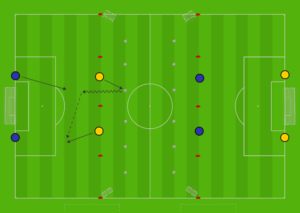Plan for the season or week by week? For me it's no-brainer, especially when it comes to long-term development. Teachers do it. Academies have a curriculum. I have found that the teams that I have worked with have improved far greater when using a progressive season plan. My earlier years coaching saw me react to performances. The improvements lasted for a week and were then forgotten as we moved onto something else.
There are key attributes that must make up a season plan for the U8, U10 and U12 age groups. I will be exploring these over the next few weeks. This week - U8's
Technical - Shielding
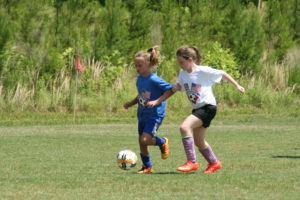
Many coaches aspire to have their teams play like a Pep Guardiola team. That's no bad thing. The technical skills that his players possess are to be admired. The weight of pass that Kevin De Bryune exhibits when playing a through ball is consistently brilliant. Both David Silva and Leroy Sane's dribbling abilities are second to none and the finishing prowess of Sergio Aguero has shown itself time and time again.
From a team perspective, Guardiola's teams have one major thing in common - possession. Generally an average of over 70% per game to be more specific. Though not an exact science, it's easy to agree with his belief that the team that dominates the ball is more likely to win games. What is often misconceived is that possession means 1 thing - passing. Passing is of course part of developing possession. But what should a player do if a pass is not on?
The skill of shielding is one that is often forgotten, yet it is linked to everything. Dribbling, turning, 1 v 1 moves, passing and receiving all require players to keep their bodies in between ball and defender. As you can see from the above photo, my former U8 is keeping the ball on her safe side - in this case her right foot - making it harder for the defender to win the ball. It also allows more time for her to decide what to do with the ball.
Introducing shielding at U8 allows for an easier progression into team possession at U10 (spoiler!). Having players that are comfortable with the ball at their feet gives team mates the time they need to recognise and move into the supporting angles that provide an out pass. It also neutralizes size differences, which are so prevalent in youth football. I had a U8 who would hold the ball for 30 seconds at a time in U9 games. Despite being the smallest player on the field, his knowledge of using the safe side made it near impossible for opponents to get the ball off him without committing a foul.
Game - Protect the Bib/Ball
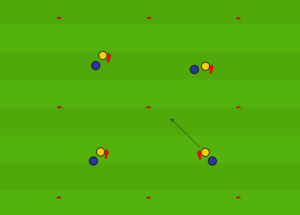
Set up a number of squares (5x5 to 8x8). Players work in pairs, one with a bib/pinny tucked into the side of their shorts. The partner has 60 seconds to steal the bib. If the partner steals the bib, they switch places. The player carrying the bib must stay in the square. Switch partners every 60 seconds.
Progression
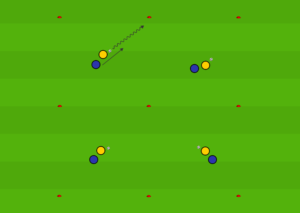
Switch the bib for a ball. Players can score points if the can nutmeg their partners.
Why it works
The bib gives the players adapt the correct body shape without having to worry about manipulating the ball. It also operates as a tag game, allowing players to work on core movement skills such as back pedals and side steps. The tight square forces close ball control and the use of all parts of the foot. Allowing nutmegs for points encourages players to see opportunities to exploit when their opponent challenges for the ball.
Tactical - Width
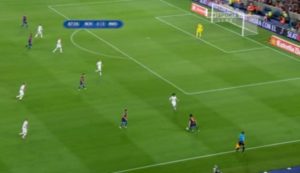
Young players grouping around the ball is something we have all experienced. We have also introduced the attacking principle of penetration at U6 and younger, by encouraging players to attack in a direction. By teaching our U8's the benefits of width allows our players to have greater success when in possession of the ball, both in their decision-making and goal scoring.
There is no more effective and simple way to do this than with 2 v 1 activities. It eliminates the additional chaos that extra players provide. As players become more comfortable using width to create an advantage when thye are 2 v 1, 2 v 2 and 3 v 2 activities can be introduced. A 2 v 1 paints the picture perfectly. If the player without the ball stays wide and the defender marks them, the player on the ball goes forward and scores. If the defender goes to the ball, a pass to the open player is on. For the mind of a 7/8 year old, this explanation ties in perfectly with our next attribute.
Game - 2 v 1 + 1
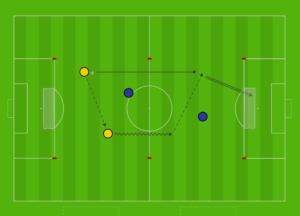
Set up a 20 x 10 field with goals at either end. The attacking team of 2 start with the ball by their goal. The defending team of 2 are positioned in a half each. They are not allowed to leave the half. The attacking team try to get the ball into the opposition half before scoring. If one of the defenders wins the ball, they attack the goal they are facing. Switch places after the turn is done.
Progression

Allow the first defender to recover into the defensive half, making it a 2 v 2.
Why it works
When the attacking players split and make the field wide, it is nearly impossible for the defender to cover both of them. The player on the ball has the most basic decision-making at their disposal - pass or dribble. The activity provides plenty of opportunities for 1-2's and 1 v 1 moves.
Social - My Friend and I

"How do I get my U8's to pass more?" is one of the more common questions asked by coaches. Developing sessions that not only encourage this, but also transfer to the game, means that we must understand how a U8 thinks socially.
Ask a 7 year old to share a toy with someone and see who they choose. 9 times out of 10 it is their best friend. Their are a number of reasons for this, but 2 that stand out are trust and familiarity. U8's still have moments where they have an egocentric attitude. Therefore, they want to know that they will get the toy back and their best friend is likely to do this.
In Football, the ball is the toy. Players at this age want the ball (something that should be embraced, not discouraged). Passing it is not an issue, as long as they believe that they will get the ball back. This is most likely to happen with their best friend (page 34). Using a possession based activity, such as a 4 v 2, is harder for players at this age to comprehend. For example, if player 1 passes to player 2, they may get the ball back. Player 2 may also pass to player 3, delaying player 1 having the "toy" again.
As with width, 2 v 1 & 2 v 2 exercises work best for encouraging players to pass the ball as a way of getting past the opposition. The following video is from my trip to the Ajax Academy in 2014 (filmed by Summit Soccer Director of Coaching Dave Stapleton). With the exception of the goal, the majority of the attacks only invove passes between 2 players. Also on show is the egocentric mindset, with players using their dribbling skills to take opponents on and have the shot themselves. These are some of the best U8's in the world.
Game - 6 Ball 2 v 1
Set up two 15x20 yard areas, with a 5 yard ball zone in between. 2 groups play at the same time. Have 2 players next to each goal, 1 on either side. All of the balls are placed in the ball zone, along with mini-goals on both sides. Both attackers go to goal with 1 ball. 1 of the defenders closes them down as soon as they enter the ball zone. If the defender wins the ball, they score in one of the mini-goals. As soon as the ball is out of play, the attackers get another ball and the next defender comes in. Repeat until all balls are gone and switch places.
Progression
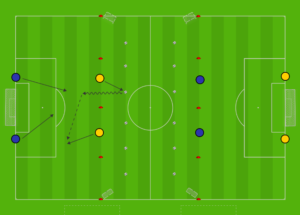
Both defenders enter the field to make it a 2 v 2.
Why it works
U8's like to score goals and this gives them plenty of chances to do that. The 2 v1 encourages them to make the best decision to score - dribble or pass to team mate. The progression adds an additional challenge so that the player away from the ball must move into the best position to receive a pass or create space for their team mate.
Physical - Changes of Speed

This past weekend, Chelsea received a royal grilling from Gary Neville for their ability to walk in unison. If the players had been 6-7 years old, he wouldn't have had a leg to stand on.
U8's are coming out of a phase where they generally use 2 speeds - all out or walking. Managing their energy output is something they are yet to learn. As we know, this is a vital aspect in Football. When I started with my U8's in North Carolina, the humidity and heat meant it was roughly 90-95% walking.
Tag games are an excellent way of introducing different variations of speed to younger players. As well as being fun for all ages, they also develop a lot of other Football specific skills such as awarness, changes of direction and creative thinking. The following game encourages players to monitor the energy output.
Game - Partner Tag

Set up a circular area. Players work in pairs and number themselves 1 and 2. Player 1 tries to get away and player 2 tries to tag them. If player 1 is tagged or runs out of bounds, they become the tagger. Play for 60 seconds and switch partners.
Progression
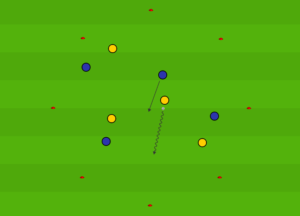
Introduce a ball for player 1 to keep from the tagger.
Why it works
Tag is a fun game for all ages. Limiting players to specific partners forces them to be constantly aware and changing the way they move - sprinting, jogging, walking. The ball adds a further challenge for the players. There are lot's of socccer-specific movements.


